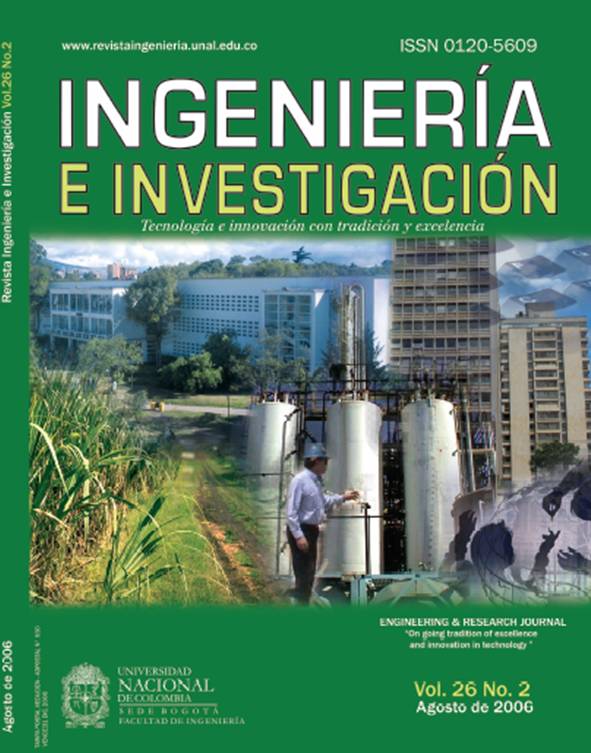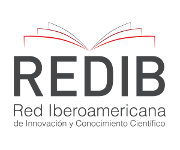Studying boundary elements’ behavior using masonry walls built with high-resistance bricks
Estudio del comportamiento de elementos de borde en la mampostería estructural con ladrillos de alta resistencia
DOI:
https://doi.org/10.15446/ing.investig.v26n2.14732Keywords:
boundary element, structural masonry, cyclic test, monotonic test, maleability, energy dissipation ability (en)elementos de borde, mampostería estructural, ensayos cíclicos, ensayos monoatómicos, ductilidad, capacidad de disipación de energía (es)
Downloads
This research was aimed at studying the behavior of masonry walls built with and without boundary elements at both ends when subjected to monotonic and cyclic lateral loads. The walls were designed to have the greatest resistance, following NSR-98 recommendations (normas Colombianas de diseño y construcción sismo resistente), except for shear reinforcement. XTRACT software was used for finding axial load cf bending moment and curvature cf bending moment curves. One monotonic test and two cyclic tests were performed for each type of wall.
Experimental results from the walls’ lateral load cf displacement curves were used for determining their ability to dissipate energy on an inelastic range (“R” force-reduction factor for seismic loads) and displacement and curvature malleability. It was found that walls built without boundary elements suffered shear failure with cracks in a stepped configuration along the bricks’ edge. The type of failure for walls built with boundary elements was shear failure in the central panel with cracks in a stepped configuration, in addition to compression failure at the edge of the boundary elements with vertical cracks on the lower part of the wall and at the contact between the wall and the boundary element. Comparison with two other studies carried out at the Universidad Nacional showed similar cyclic behavior, regardless of the clay brick’s strength. The “R” values obtained for both types of walls were lower than the recommended values given by NSR-98. It was determined that walls having boundary element have greater displacement malleability than walls without boundary elements.
Esta investigación tuvo por objeto estudiar el comportamiento de muros de mampostería estructural construidos con elementos de borde en ambos extremos, y sin ningún elemento de borde, al ser solicitados ante cargas laterales monotónicas y cíclicas. Los muros se diseñaron por resistencia última, siguiendo las recomendaciones de las Normas Colombianas de Diseño y Construcción Sismo Resistente NSR-98 con la excepción del refuerzo a corte. Se encontraron también las curvas capacidad carga axial-momento flector y curvas momento-curvatura, empleando el software XTRACT. Por cada tipo de muro se realizaron un ensayo monotónico y dos cíclicos. Con los ensayos de los muros y a partir de las curvas de carga lateral-desplazamiento se determinó la capacidad de disipación de energía en el rango inelástico (factor de reducción de fuerzas sísmicas R) y la ductilidad de desplazamiento y curvatura. En los ensayos se halló que las fallas presentadas en los muros sin elementos de borde fueron por corte con formación de grietas en escalerilla. Los muros con elementos de borde fallaron por cortante en el panel central con formación de grietas en escalerilla y por compresión, con presencia de grietas verticales en la parte inferior del muro y en el contacto entre el panel central y los elementos de borde. Al comparar los resultados de este estudio con otras dos investigaciones realizadas en la Universidad Nacional se encontró que el comportamiento fue similar entre todos los muros ensayados ante cargas cíclicas, sin importar la resistencia de la unidad de arcilla. Los valores obtenidos del factor R, para los dos tipos de muros ensayados fueron inferiores a los valores recomendados por la NSR-98. Los muros con elemento de borde presentaron una mayor ductilidad de desplazamiento respecto de los muros sin elementos de borde.
References
Cortes, J. C. y Medina, J. D., Comportamiento Inelástico de Muros en Mampostería Reforzada., Tesis de Pregrado, Universidad Nacional de Colombia, Bogotá, 2005.
FEMA 306., Evaluation of Earthquake Damaged Concrete and Masonry Wall Buildings. Technical Resources., 1996.
FEMA 307., Evaluation of Earthquake Damaged Concrete and Masonry Wall Buildings. Technical Resources., 1998.
García, L. E., Dinámica Estructural Aplicada al Diseño Sísmico., Universidad de los Andes, Colombia, 1998.
Imbsen, XTRACT, Version 2.64, Copy 2002., Cross Section Analysis Software for Structural Engineers Beginning Level - Example 1 and Example 2, 2002.
Mander, P P, Observed Stress-Strain Behavior of Confined Concrete., J. Structural. Eng., ASCE, 114, 8, 1988, pp. 1827-1849. DOI: https://doi.org/10.1061/(ASCE)0733-9445(1988)114:8(1827)
Medina, F., Estudio del Comportamiento de Elementos de Borde en la Mampostería Estructural., Tesis de Maestría, Universidad Nacional de Colombia, Bogotá, 2005.
Normas Colombianas de Diseño y Construcción Sismo Resistente NSR-98., Ley 400 de 1997, Decreto 33 de 1998, Decreto 034 de 1999, Asociación Colombiana de Ingeniería Sísmica, Bogotá, 1999.
Park, R. y Paulay, T., Estructuras de Concreto Reforzado., Editorial Limusa, 1983.
Restrepo, J. C., Estudio del Comportamiento de Elementos de Borde en la Mampostería Estructural con Ladrillos de Alta Resistencia., Tesis de Maestría - Estructuras, Universidad Nacional de Colombia, Bogotá, 2006.
San Bartolomé, A., Muñoz, A., Madueño, G. y Cavero, R., Comportamiento Sísmico de Placas de Concreto Reforzadas con Mallas Electrosoldadas., Pontificia Universidad Católica del Perú, 1999.
Paulay, T. y Priestley, M.J.N., Seismic Design of Reinforced Concrete and Masonry Buildings, 1992. DOI: https://doi.org/10.1002/9780470172841
How to Cite
APA
ACM
ACS
ABNT
Chicago
Harvard
IEEE
MLA
Turabian
Vancouver
Download Citation
License
Copyright (c) 2006 Juan Carlos Restrepo Mejía, Caori Patricia Takeuchi Tam

This work is licensed under a Creative Commons Attribution 4.0 International License.
The authors or holders of the copyright for each article hereby confer exclusive, limited and free authorization on the Universidad Nacional de Colombia's journal Ingeniería e Investigación concerning the aforementioned article which, once it has been evaluated and approved, will be submitted for publication, in line with the following items:
1. The version which has been corrected according to the evaluators' suggestions will be remitted and it will be made clear whether the aforementioned article is an unedited document regarding which the rights to be authorized are held and total responsibility will be assumed by the authors for the content of the work being submitted to Ingeniería e Investigación, the Universidad Nacional de Colombia and third-parties;
2. The authorization conferred on the journal will come into force from the date on which it is included in the respective volume and issue of Ingeniería e Investigación in the Open Journal Systems and on the journal's main page (https://revistas.unal.edu.co/index.php/ingeinv), as well as in different databases and indices in which the publication is indexed;
3. The authors authorize the Universidad Nacional de Colombia's journal Ingeniería e Investigación to publish the document in whatever required format (printed, digital, electronic or whatsoever known or yet to be discovered form) and authorize Ingeniería e Investigación to include the work in any indices and/or search engines deemed necessary for promoting its diffusion;
4. The authors accept that such authorization is given free of charge and they, therefore, waive any right to receive remuneration from the publication, distribution, public communication and any use whatsoever referred to in the terms of this authorization.



























